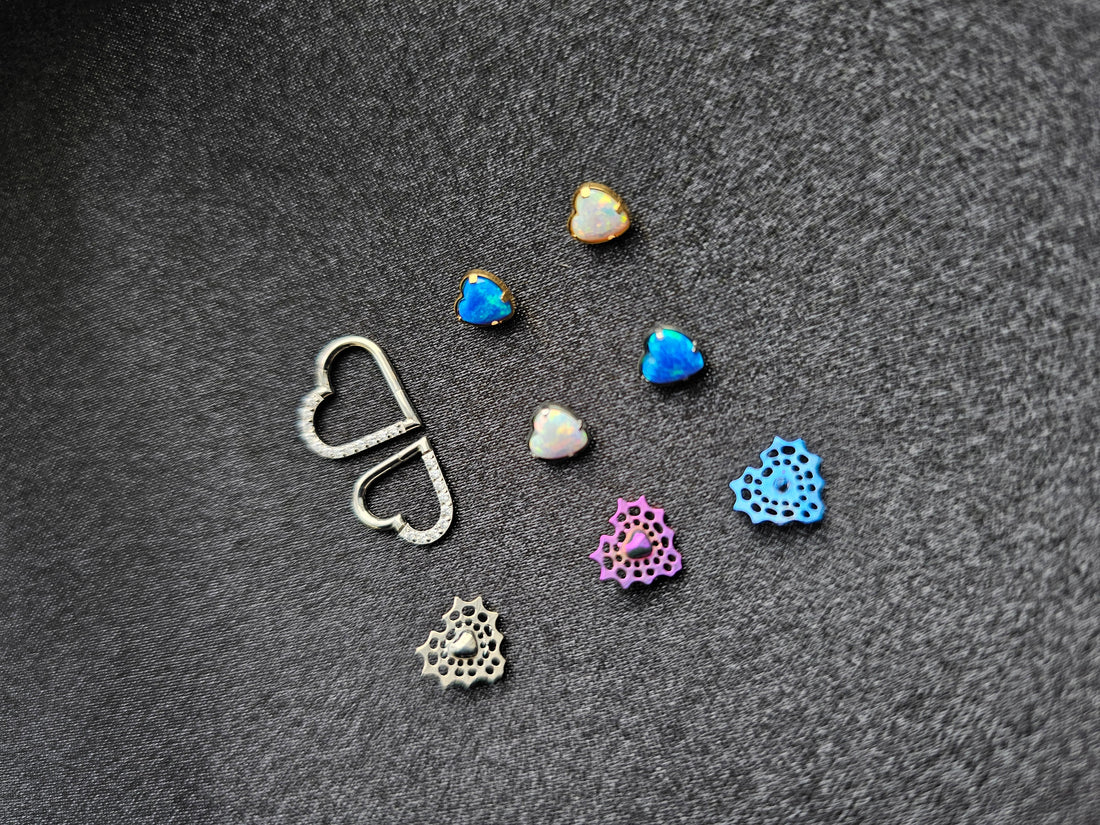
Basics about piercing
Share
A Comprehensive Guide to Piercings - For Beginners
Piercings are one of the oldest forms of body modification, used by various cultures worldwide to express identity, religious beliefs, and beauty. Today, piercings are popular as fashion accessories that highlight personal style. However, before getting one, it's important to familiarize yourself with the process, materials, aftercare, and potential risks involved.
What is a Piercing?
A piercing is a procedure where a small opening is made through the skin or tissue to insert jewelry. Piercings are popular on different parts of the body, including ears, nose, eyebrows, lips, tongue, nipples, navel, and other areas.
Types of Piercings Based on Location
- Ears: Earlobes or cartilage.
- Face: Eyebrows, nose, lips, or tongue.
- Body: Navel, nipples, or other specific areas.
- Intimate Piercings: On intimate body parts.
The Piercing Procedure
The piercing process is quick but requires a sterile environment and a trained professional. Here are the basic steps you can expect:
Consultation and Preparation:
An experienced piercer will review the desired area, present options regarding jewelry size and material, and answer any questions. It’s advisable to inform them of any allergies (e.g., nickel).
Sterilization:
The piercer will ensure that the equipment and the area to be pierced are completely sterile to minimize infection risks.
Marking and Piercing:
The piercer will mark the location of the piercing to confirm its accuracy. They will then use a sterile needle (not a piercing gun) to create the opening and insert the jewelry. Needles are preferred as they are more precise and less traumatic than piercing guns.
Inserting the Jewelry:
Once the opening is made, the piercer inserts the chosen jewelry. Opt for high-quality materials like titanium, niobium, or bioplast, as they are skin-friendly.
Piercing care
Piercing care is crucial for successful healing and infection prevention. Healing times range from weeks to months, depending on the location and care provided.
Basic care Instructions
- Cleaning: Clean your new piercing 1-2 times daily with saline solution or mild antiseptic. Avoid alcohol or hydrogen peroxide as they can dry out and irritate the skin.
- Avoid Touching: Do not touch the piercing without thoroughly washing your hands. Frequent contact with dirty hands can lead to infections.
- Prevent Mechanical Damage: Be cautious of mechanical damage, especially with oral or navel piercings, and avoid friction or pulling on the jewelry to prevent inflammation.
- Do Not Change Jewelry Prematurely: Wait until the piercing has fully healed before changing jewelry.
Healing Times Based on Location
- Earlobe: 6-8 weeks
- Ear cartilage: 3-6 months
- Nose: 2-4 months
- Lips and tongue: 4-6 weeks
- Navel: 6-12 months
Possible Risks and Complications
Although piercings are generally safe when done by a professional, certain risks exist:
- Infection: Symptoms include redness, swelling, pain, and discharge. If you notice these signs, see a doctor immediately.
- Allergic Reactions: People sensitive to certain metals (e.g., nickel) may experience itching, redness, or even rashes. To reduce risks, choose hypoallergenic materials like titanium, niobium, or bioplast.
- Keloids and Scars: Some individuals are prone to keloids, which are thickened scars. Consult your piercer and carefully care for your piercing to minimize this risk.
- Jewelry Migration: Certain piercings, such as navel piercings, may experience jewelry migration due to body activity or overloading.
Tips for Choosing the Right Jewelry
When selecting jewelry, prioritize quality materials to reduce the risk of allergic reactions and infections. Recommended materials for initial piercings include:
- Titanium: Hypoallergenic and lightweight, ideal for new piercings.
- Niobium: Softer but visually appealing and skin-friendly.
- Surgical Steel: Suitable for healed piercings if you are not nickel-sensitive.
- Bioplast and PTFE: Flexible materials, excellent for sensitive skin and oral piercings.
Choosing the Right Piercer
For a safe experience, choose an experienced piercer with good references and a clean working environment. Before your appointment, check if the studio is certified and uses sterile equipment. Don’t hesitate to ask questions—a good piercer will be happy to address your concerns and reassure you.
While piercings may seem like a simple modification, proper preparation, high-quality materials, and consistent aftercare are necessary to ensure longevity and a beautiful aesthetic. Being well-informed about the process and committed to aftercare is essential for healthy skin and comfortable jewelry wear.
